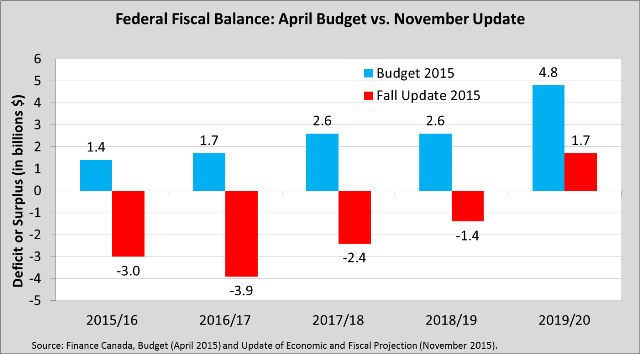Canada’s deteriorating federal fiscal position has no end in sight
Today, newly minted federal Finance Minister Bill Morneau released his first Update of Economic and Fiscal Projections, which is intended to give Canadians a heads up on the state of the economy and federal finances.
Unfortunately, the outlook isn’t positive, as the government now projects budget deficits for this year and the next three—not accounting for any of the Liberals’ proposed spending commitments. This is a notable departure from the projected surpluses contained in the Conservatives’ April 2015 budget (see chart below).

The latest numbers suggest Canadians can expect budget deficits in 10 out of 11 years, starting in 2008/09 when the federal government ran its first deficit after 11 consecutive surpluses, up to 2018/19.
The main cause for the swing from surpluses to deficits since the Conservative 2015 budget is weaker than expected economic growth and commodity prices. For instance, the budget used an average projection for nominal GDP growth from 2015 to 2019 of 3.9 per cent. The average projection for the same period has now been revised down to 3.7 per cent. Similarly, the projected average price per barrel of oil has fallen from $70 to $61.
Weaker economic growth translates into lower tax revenues for the government and in this case a deteriorating fiscal balance.
Importantly, Minister Morneau’s update is based on the status quo in terms of federal policies. That is, it does not include any of the new policy measures proposed by the Liberals, who campaigned on ramping up infrastructure spending and running annual deficits of approximately $10 billion, at a time when surpluses were expected. This means the fiscal outlook will worsen—in terms of larger and perhaps more persistent deficits—when the government releases its budget next year, assuming it moves ahead with its campaign tax and spending plans.
What are we to make of all this?
Deficits can make sense when the economy is hit by a severe shock, but we are nearly seven years removed from the recession of 2008-09. While Canada’s economy is hardly firing on all cylinders, there’s a risk that deficits are becoming “business as usual.” We saw a similar scenario in the 1970s, 1980s and early 1990s when the federal government ran 27 consecutive deficits. These deficits hampered Canada’s ability to enact competitive tax policies and led to a dramatic accumulation of debt, with interest payments on the debt consuming more than one-third of federal revenues.
Canadians should also be wary of further accelerated increases in government spending, especially in the name of stimulating the economy. A vast body of academic literature casts serious doubt on the ability of government stimulus spending to boost economic activity.
Budget deficits seem to have again become routine in Ottawa. This is a troubling development given the economic problems persistent deficits cause and the dubious nature of claims that these deficits will help stimulate the economy in the years ahead.
A more effective and proven course is to eliminate the deficit through spending reductions and reforms, and refocus on pro-growth economic policies, which incidentally, is something the Liberals expressed as one of their campaign priorities.
Authors:
Subscribe to the Fraser Institute
Get the latest news from the Fraser Institute on the latest research studies, news and events.

